
Age is a huge risk factor for sustaining a spinal cord injury (SCI). In fact, according to the University of Rochester Medical Center, young adult males between the ages of 15 and 35 are at the highest risk of spinal cord injuries, which often occur due to accidents, violence, and sports injuries. However, not everyone is young when they become injured.
180 Medical Community member James generously shares his story of recovery from a spinal cord injury he sustained 11 years ago when he was 70 years old.
Spinal Cord Injury Late in Life: James’ Story
“I have been blessed with a body that would do almost anything I asked of it,” says James. He always excelled in social and physical activities. He recalls that during a set of intramural tests in high school, “out of 700 or so boys, I finished in the top three and received a letter for a letterman jacket, which I still have.”
Then in his golden years at the age of 70, James was involved in a bad motorcycle wreck. It was the Saturday after Thanksgiving in 2011.
“I still don’t know what caused the wreck,” James says. “I only know that due to a number of busted ribs and a broken clavicle, the hospital put me in a light coma for 3 weeks so I wouldn’t be in too much pain while I healed.”
Then came the news. “When I finally woke up, I realized I was unable to feel or move anything below my chest. I was now a paraplegic.”
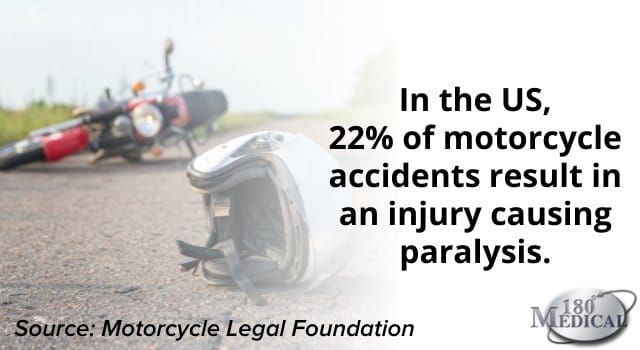
Recovery After Spinal Cord Injury at Shepherd Center
When it came time to begin rehabilitation therapy, Shepherd Center, one of the top non-profit rehabilitation hospitals in the southeast, accepted James. So off he went on an ambulance ride to Atlanta. It wasn’t the most comfortable ride, he admits, but he jokes that “if you haven’t ridden flat on your back on a gurney for 5 hours, you haven’t lived.”
Once he arrived, the doctors at Shepherd Center confirmed he had a T4-level spinal cord injury. Now his focus was on just one thing.
“Like all people with a new spinal cord injury, I just wanted to get back to the way I was before the wreck – to walk, run, and play – and the sooner the better!”

Beginning Rehabilitation Therapy
During the four months of his stay, each day included around six hours or so of different types of therapy, including physical and occupational therapy. Also, due to his concussion, James also worked with a speech therapist for a few weeks.
In addition, the center arranged for sessions with a mental health therapist, just to make sure he was coping well with his sudden injury. James saw firsthand how difficult it was for many other people at the center. To this day, he’s still thankful for the love and support of his wife Judy throughout that time.
“With Judy’s help, I did a pretty good job of handling the mental aspects of the wreck,” James says. But the physical therapy was no cakewalk.
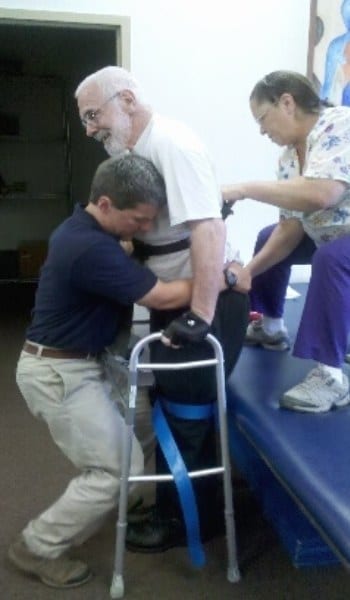
“Every day, I tried to move my legs, feet, toes, ANYTHING,” he shares. “You have no idea how frustrating it can be to look at your foot, mentally tell it to move, and nothing happens.”
Despite his frustration, James kept working every day with his physical therapist and meeting new challenges, like the scary task of learning to transfer (the act of moving from one’s wheelchair to a bed, toilet, car seat, etc.).

A Breakthrough in Therapy
Then after about four weeks of therapy, something major happened. James was able to move a few of his left toes. It was confirmation that he had an incomplete spinal cord injury. In other words, “it signified that nerves could still communicate somewhat below my injury level.” He hoped it was also an indication that things were getting better.
After that, therapy began to intensify. James began using an assistive treadmill for people with a spinal cord injury
James explains how it works: “As the patient, you are strapped into a vest that can support your weight. You’re standing up on your feet on a treadmill that slowly moves. Your job is to move each leg if you can while a person on each side helps. They move the leg for you if you can’t independently, and you can look into a mirror to see yourself walking again.”
What was that like? “It’s a very emotional experience for someone with a spinal cord injury. You have been wanting and trying to walk for so long without being able to. I think most people probably cry. I know I certainly did,” James says.
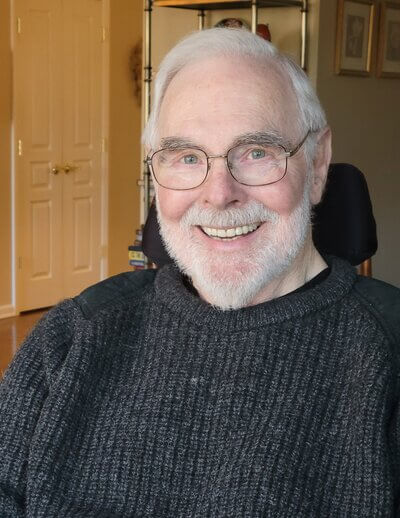
Returning Home After Spinal Cord Injury
After four long months, Judy and James loaded up their car with new equipment and catheter samples and finally headed back home.
A later evaluation appointment during outpatient therapy revealed that James had continued to heal slowly after his incomplete spinal cord injury. “I now had the ability to sense sharp or dull sensations as well as hot and cold sensations on the right side of my body.”
His doctor determined he had a rare type of spinal injury, Brown Séquard Syndrome, which is also known as Partial Spinal Sensory Syndrome or hemiparaplegia. It was good news, but James still had a long way to go with therapy.
He learned how to maneuver his manual wheelchair up steep slopes. Also, he began using a functional electrical stimulation (FES) bike during outpatient therapy. At first, he couldn’t move the pedals at all. Then, after six months, he was thrilled to see he was making the pedals move on his own without electrical stimulation. “Another big step forward!”
It took years of work with his therapists to try and walk on his own, but he finally made it about 200 feet with a walker.
The Importance of Choice of Catheters
After a few years of living with a spinal cord injury late in life and self-catheterizing with straight catheters, James got in touch with 180 Medical. Now he’s been with us for over 8 years.
Part of what makes 180 Medical unique is that we emphasize the importance of choice for our customers. We know that there is no one-size-fits-all approach when it comes to catheter supplies, which is why we help you try out and find the brand and type that works best for your needs.
James can attest to that. “180 Medical has been very supportive in helping me try out different catheters to find which one I liked the best. Trying out options like hydrophilic catheters and closed system catheters have made things much easier for me.”

These days, James’ catheter of choice is the LoFric® Hydro-Kit™, which is one of many all-in-one closed system catheter options available at 180 Medical.
About the LoFric Hydro-Kit Catheter
The LoFric® Hydro-Kit™ Hydrophilic Closed System Catheter Kit is a great option for people with spinal cord injuries since it includes insertion supplies as well as an integrated urine collection bag for convenience.

All you have to do is pop the included water sachet, and the low-friction hydrophilic coating quickly activates to lubricate the catheter, providing fast, comfortable catheterization.
Also, the LoFric Hydro-Kit is a touch-free or no-touch catheter option, which may help reduce the risk of urinary tract infections (UTIs).
“It’s allowed me to go the longest time without getting a UTI,” James says.
Still Going Strong at 81 Years Old
James definitely had a hard road to recovery after sustaining a spinal cord injury late in life at 70 years old. However, he hung on and stayed determined to make the most of his situation and do his absolute best.
“I can still do pretty much everything I used to love doing. I’ve just had to figure out a new way of doing it. Anyway, walking is overrated,” he says with a laugh. “The wheelchair is a good substitute for legs.” He can transfer to and from bed in the morning and night and get ready for his day. He even walks from the bed to his wheelchair, and a CNA helps him with more difficult tasks like showering and getting dressed. “I’m satisfied with where I ended up, but in the beginning, I had no idea it would take as long or require as much effort as it did! It was the most difficult thing I’ve ever done,” he admits.
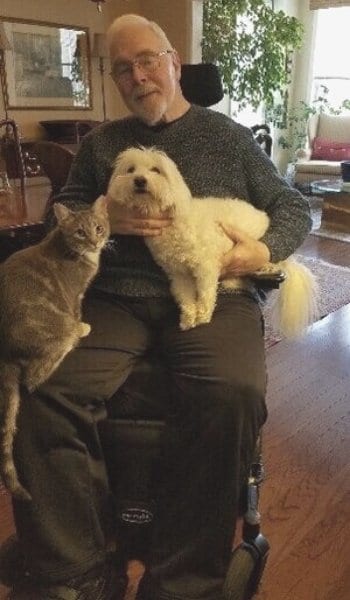
“I have a wonderful life with a loving wife of 58 years,” he says. He lives with his wife Judy in a continuing care retirement community, where he participates in lots of social activities and several committees. In addition to playing the bass clarinet in several local bands, he also likes to use the pool for swimming exercises and go out to the local shooting range and shoot pistols. Plus, he has the love and support of many friends in the community too.
“I am truly blessed and thankful,” he says. “Though largely unplanned, this has been a truly unforgettable trip!”
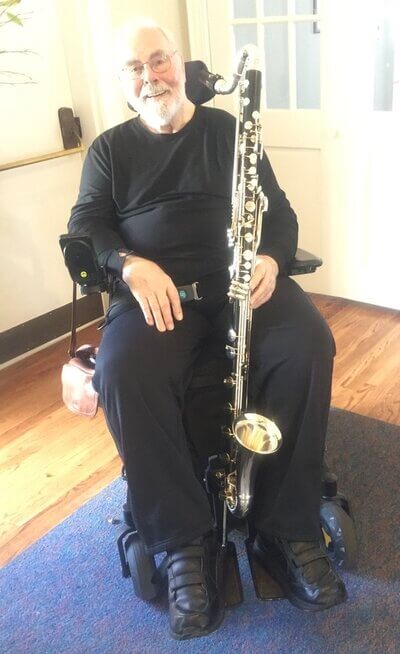
We’re proud to share James’ inspiring story and to be his catheter company of choice.